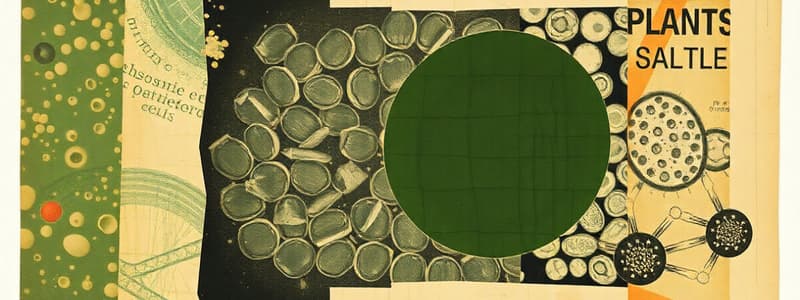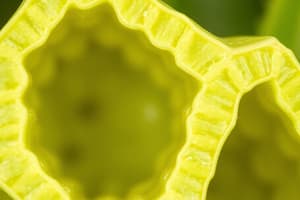Podcast
Questions and Answers
Which of the following statements is TRUE about cells?
Which of the following statements is TRUE about cells?
- Cells are only found in plants and animals.
- Cells are only found in multicellular organisms.
- Cells are always very complex and contain many organelles.
- Cells are considered to be the most basic unit of life. (correct)
The statement 'all plants and animals are composed of cells' is best described as which of the following?
The statement 'all plants and animals are composed of cells' is best described as which of the following?
- A theory. (correct)
- An observation.
- A hypothesis.
- A law.
Which of these organisms are always composed of a single cell?
Which of these organisms are always composed of a single cell?
- Animals.
- Bacteria. (correct)
- Plants.
- Fungi.
The term 'envelop' in the content refers to what part of the cell?
The term 'envelop' in the content refers to what part of the cell?
Which of the following is NOT a characteristic of cells?
Which of the following is NOT a characteristic of cells?
Which of the following is NOT true about the cell wall?
Which of the following is NOT true about the cell wall?
What is the primary function of the cell wall in mature cells?
What is the primary function of the cell wall in mature cells?
Why does the cell wall limit cell expansion due to osmosis?
Why does the cell wall limit cell expansion due to osmosis?
Which of the following organisms is most likely to possess a cell wall?
Which of the following organisms is most likely to possess a cell wall?
What is the relationship between the cell wall and turgor pressure?
What is the relationship between the cell wall and turgor pressure?
What is a key feature of plant cells that distinguishes them from animal cells?
What is a key feature of plant cells that distinguishes them from animal cells?
What role do lignified secondary cell walls play in the evolution of plants?
What role do lignified secondary cell walls play in the evolution of plants?
How do cell walls benefit plants in comparison to animals?
How do cell walls benefit plants in comparison to animals?
Which of the following statements about plant cell walls is false?
Which of the following statements about plant cell walls is false?
In what way do plant cell walls influence plant growth?
In what way do plant cell walls influence plant growth?
What is the primary function of pumps in cellular processes?
What is the primary function of pumps in cellular processes?
Which process involves excreting materials from a cell?
Which process involves excreting materials from a cell?
What can membrane fusion transport?
What can membrane fusion transport?
How are particles that are too large to pass through the membrane typically handled by the cell?
How are particles that are too large to pass through the membrane typically handled by the cell?
Which of the following materials can be excreted through exocytosis?
Which of the following materials can be excreted through exocytosis?
What is the primary function of membrane proteins according to the provided information?
What is the primary function of membrane proteins according to the provided information?
Which type of membrane protein is described as being loosely attached by ionic interactions?
Which type of membrane protein is described as being loosely attached by ionic interactions?
Which of the following statements about membrane proteins is incorrect?
Which of the following statements about membrane proteins is incorrect?
What aspect of membrane proteins is highlighted in relation to their roles in the cell?
What aspect of membrane proteins is highlighted in relation to their roles in the cell?
Which characteristic best describes intrinsic proteins compared to extrinsic proteins?
Which characteristic best describes intrinsic proteins compared to extrinsic proteins?
What material contributes to the strength and toughness of secondary cell walls?
What material contributes to the strength and toughness of secondary cell walls?
Which group of plants is characterized by lacking lignified cell walls?
Which group of plants is characterized by lacking lignified cell walls?
What is a characteristic of lignin as a material?
What is a characteristic of lignin as a material?
Which of the following statements about secondary cell walls is true?
Which of the following statements about secondary cell walls is true?
Which of the following plant types typically possesses lignified secondary cell walls?
Which of the following plant types typically possesses lignified secondary cell walls?
Flashcards
Cell Wall
Cell Wall
A rigid structure that surrounds the cell in plants and fungi.
Function of Cell Wall
Function of Cell Wall
Limits expansion of the cell due to osmosis.
Composition of Cell Wall
Composition of Cell Wall
Commonly made of cellulose in plants and chitin in fungi.
Cell Wall vs. Cell Membrane
Cell Wall vs. Cell Membrane
Signup and view all the flashcards
Mature Cells and Cell Wall
Mature Cells and Cell Wall
Signup and view all the flashcards
Cells
Cells
Signup and view all the flashcards
Single-celled organisms
Single-celled organisms
Signup and view all the flashcards
Multicellular organisms
Multicellular organisms
Signup and view all the flashcards
Bacteria
Bacteria
Signup and view all the flashcards
Unit of life
Unit of life
Signup and view all the flashcards
Pumps
Pumps
Signup and view all the flashcards
Membrane Fusion
Membrane Fusion
Signup and view all the flashcards
Exocytosis
Exocytosis
Signup and view all the flashcards
Endocytosis
Endocytosis
Signup and view all the flashcards
Transport of Materials
Transport of Materials
Signup and view all the flashcards
Lignified Secondary Cell Walls
Lignified Secondary Cell Walls
Signup and view all the flashcards
Difference Between Plants and Animals
Difference Between Plants and Animals
Signup and view all the flashcards
Structural Reinforcement
Structural Reinforcement
Signup and view all the flashcards
Vertical Growth in Plants
Vertical Growth in Plants
Signup and view all the flashcards
Secondary Cell Walls
Secondary Cell Walls
Signup and view all the flashcards
Lignin
Lignin
Signup and view all the flashcards
Bryophytes
Bryophytes
Signup and view all the flashcards
Lignified Cell Walls
Lignified Cell Walls
Signup and view all the flashcards
Plant Cell Walls
Plant Cell Walls
Signup and view all the flashcards
Metabolism
Metabolism
Signup and view all the flashcards
Membrane proteins
Membrane proteins
Signup and view all the flashcards
Extrinsic proteins
Extrinsic proteins
Signup and view all the flashcards
Compartmentalization
Compartmentalization
Signup and view all the flashcards
Ionic attachment
Ionic attachment
Signup and view all the flashcards
Study Notes
Plant Cell Structure
- Plant cells are composed of protoplasm and a cell membrane
- Biologists identify two types of cells: prokaryotic (simple, no nucleus) and eukaryotic (nucleus and membrane-bound organelles). Plant cells are eukaryotic.
- Plant cells are surrounded by a rigid cell wall, a key difference from animal cells.
- The cell wall is composed of cellulose microfibrils, polysaccharides, lignin, and other components like calcium carbonate, waxes, and cutin.
Plant Cell Wall
- Plant cell walls are vital for structural support and preventing uncontrolled expansion due to osmosis.
- Two types of cell walls exist: primary cell walls (thin, present in young cells) and secondary cell walls (thicker and stronger, present in mature cells)
- The secondary cell wall is strengthened by lignin.
- Secondary cell walls form after most cell growth.
- Cell walls have pits for communication between cells
Plant Cell Membranes
- Cell membranes are primarily composed of fatty-acid lipids and proteins.
- Two types of membrane proteins exist: extrinsic (loosely attached to lipid bilayer) and intrinsic (firmly embedded).
- Lipids in membranes are phospholipids and sterols (like cholesterol), with an amphiphilic property (attracting both water and fat).
- Membranes control molecular passage (flexible & selective).
- Membranes are essential for cell functions (transport, metabolism)
Cytoplasm and Cytosol
- Cytoplasm is the substance enclosed by the cell membrane.
- A large cellular activity happens in the cytoplasm, including glycolysis and nuclear division.
- The inner portion is called the endoplasm and the outer portion ectoplasm.
- Cytosol is the fluid component of the cytoplasm, surrounding organelles and where crucial metabolic reactions occur.
- These substances facilitate cellular activities and communication.
Cell History
- In 1665, Robert Hooke observed cork and named the chambers "cells".
- Schleiden and Schwann (1838) proposed the cell theory: all living things are made of cells, and the cell is the fundamental unit of life.
- Virchow (1858) expanded the theory with the principle that all cells come from pre-existing cells.
Studying That Suits You
Use AI to generate personalized quizzes and flashcards to suit your learning preferences.



